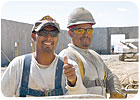
In my last column, “Safety Training That Works with Latinos,” (W&C, November 2007) I discussed what safety training is and what it does, and listed some important factors to consider when teaching safety to Latino laborers.
In this article, the second of the two-parts, I will explain the three specific concepts one must understand and implement to have high levels of success in training safety with Latino employees. They are:
1. You must understand machismo.
2. You must leverage love of family and responsibility to family.
3. You must train with a good dose of “show and tell.”

Understanding Machismo
Most images of machismo, or in American vernacular, the “macho man,” are negative. Although a case could be made for engendering healthy male self-respect, let’s move past that part immediately.The Latino culture, specifically the male culture, is greatly influenced by machismo. Machismo is defined as a strong sense of masculine pride or an exaggerated masculinity. It is the opposite of all things feminine, soft or sensitive.
Most Latino men have some element of machismo. Machismo has the same root word as Mach 1, which we know as the speed of light. Mach 1 is all about power and speed, or, in this instance, the appearance of power and speed. A significant percentage of Latino laborers pride themselves on getting things done quickly. They work fast. This is part of machismo. It can be a good thing, but good things that are out of control quickly become risky things that can become dangerous to oneself or to others.
Machismo is a front for insecurity. It is insecure men putting on an outward facade of security, strength and control. The key to remember here is that it is, in fact, a front. It is a facade that continues to be perpetuated primarily due to social pressure.
It affects how one should view and train safety to Latinos. Many Latinos do not want to wear safety glasses, hardhats, build scaffolding or do anything else that makes them appear weak. It is for this reason that it is not uncommon for people to use safety equipment properly while they are being viewed by management, but as soon as management leaves, go back to doing things without these safety precautions. Why do they do this so often? First, they feel safety equipment slows work down, and second, to some people it just feels weak.
We must understand these dynamics and tendencies so we can train to counteract them. To a large degree, machismo is the No. 1 safety enemy of the Latino worker today.
Here are a few suggestions that may help counteract the negative effects of machismo in your safety training:
1. Don’t openly talk about machismo to your workers. You will just put them on the defensive, and that is not the point.
2. Talk more about quality than speed. If you have any type of piece-rate program in place, make sure it is tied directly into safety and quality as well as speed.
3. Make sure that all your supervisors, superintendents and management team members always wear and use appropriate safety equipment to set a positive example.
Leverage Love of Family
Who knows where the line crosses between love and sense of responsibility? One thing is certain: Most Latino men inherently have a good sense for this. When doing safety training with Latinos, I would strongly encourage using lines like the following:• ¿Qué pasa a sus hijos si usted se lesiona seriamente?:
What happens to your kids if you get seriously hurt?
• Ten cuidado, sus padres dependen de usted.
Be careful, your parents depend on you.
• Su esposa lo ama y lo necesita. No tome riesgos.
Your wife loves and needs you. Don’t take risks.
The list could go on and on: The three great motivators for safety to the Latino male are children, parents and spouse.
Many Latino laborers do not read well in Spanish, let alone English, due to a lack of educational opportunities in their home countries. Thus, training for them should be highly visual and highly personal. This means “show and tell,” having a leader in the company conduct the training to show the importance of what is being taught. Too often, when you have a co-worker show them, the underlying message is that it isn’t all that important. In fact, it is so unimportant it is delegated to a person who is not even an official, much less a trainer, in the organization. In short: Train safety visually, but make sure you have the right people doing this training.
Training Camp
Role playing is an effective way to train for safety, but very few companies have “training camps” where their employees can act things out (good and bad) before they happen. Translating (or interpreting) things from English to Spanish and hoping against all hope that workers “get it” is not effective and that’s why the Latino accident rate is so high in this country compared to the Anglo accident rate. It is time we start getting serious about training in the right way. Set up an area with a training zone that looks and feels like an actual jobsite. Train people in a controlled environment–you could even put in nets to catch them–so they can know what it actually feels like to fall off a roof or building.Telling real-life stories is also instructive. When was the last time you read about how someone got seriously hurt so you could tell his story to your workers? When was the last time you looked up diagrams or pictures on the Internet to visually tell your stories?
If your company starts “showing and telling,” your people will actually look forward to your safety meetings. They will actually learn something. They will actually learn to apply those safety lessons. And you will decrease risk, save money, and just generally feel a lot better about yourself as you watch your lost-time accidents decrease at the speed of light!
Since many of us struggle with spinning a good yarn I would like to ask for a favor. Do you have a story to tell that others could use to promote safety? If so, please e-mail it to me at the address below. In my next article I’ll publish a link where people can download those stories. Perhaps we can come up with several stories that will help us all stay a bit safer on the job. Don’t worry, we will change names and locations to protect the fallen.





